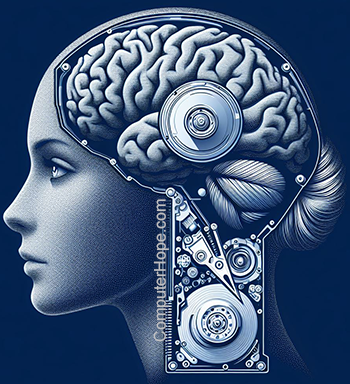How does the computer relate to the human body?

To help new users understand the computer components and their functions, we often make comparisons with parts of the human body. The following list refers to various human body parts and then gives an analogy of how they relate to computer parts.
The examples below are a great starting point to give new computer users a better understanding of the parts of a computer. However, this information only provides a basic overview. See the related information links at the bottom of this page to continue learning more about the computer and how it works.
Human brain
The brain is actually like three parts of the computer:
- The hard drive is like the brain because it's used to permanently store all (non-volatile) files and information on the computer.
- The RAM (Random-Access Memory) is also like another part of the brain that handles conscious thought, temporarily (volatile) holding information that's later forgotten.
- The software on a hard drive has instructions the computer uses to know how to operate.
Nervous system
The human nervous system is what connects everything in your body. The computer also has a nervous system called a motherboard, which connects all computer parts and allows them to communicate. A computer motherboard makes these connections by being a big PCB (Printed Circuit Board) and having different types of buses that transmit the data.
Spinal cord
The spinal cord helps the body move. Like the spinal cord, a CPU (Central Processing Unit) takes instructions from the software and tells the computer what steps it should perform.
Many incorrectly believe the CPU is the "brain" of the computer. However, the CPU is only a complex calculator, and software is the component doing the "thinking."
Face
A monitor or other display device is like a human face. It is the part you spend the most time looking at while working on the computer.
Eyes
The human eyes are like a webcam or other camera connected to the computer. Once one of these input devices is connected, it can accept any visual input.
Ears
The ears are like a computer microphone. Once connected, a microphone is a peripheral device that accepts any audible input.
Mouth
The human mouth could be one of many output devices used with a computer. However, we believe the speakers and printer are the most closely-related devices, which help the computer communicate with the user. Speakers and printers output information to computer users, like the mouth that speaks, or outputs, words and information to other people.
Heart
The human heart keeps the body and all its parts alive. Like the heart, the computer power supply keeps the computer powered on and running. If the computer were to lose power and does not have a battery backup, it would stop working. However, unlike humans, a computer can remain powered off for days, months, or years and continue working once the power is restored.
A heartbeat is a term used to also help describe a tick or a measurement of time.
Pores
Just like you, the computer needs to moderate its temperature. Like the sweat glands in your skin, computers have case fans and heat sinks to help prevent them from overheating. If a computer or any of its sensitive parts get close to overheating, a computer turns itself off to help prevent damage.
Hands
The hands allow us to move and manipulate other objects. The computer uses input devices like the keyboard and mouse as its hands to interact with the user.
Skin and bones
The computer chassis (case) holds everything together and protects its sensitive equipment, much like the skin and bones do in a human body.
What are other computer terms that relate to the body?
The following are other computer-related terms containing human body terms.
